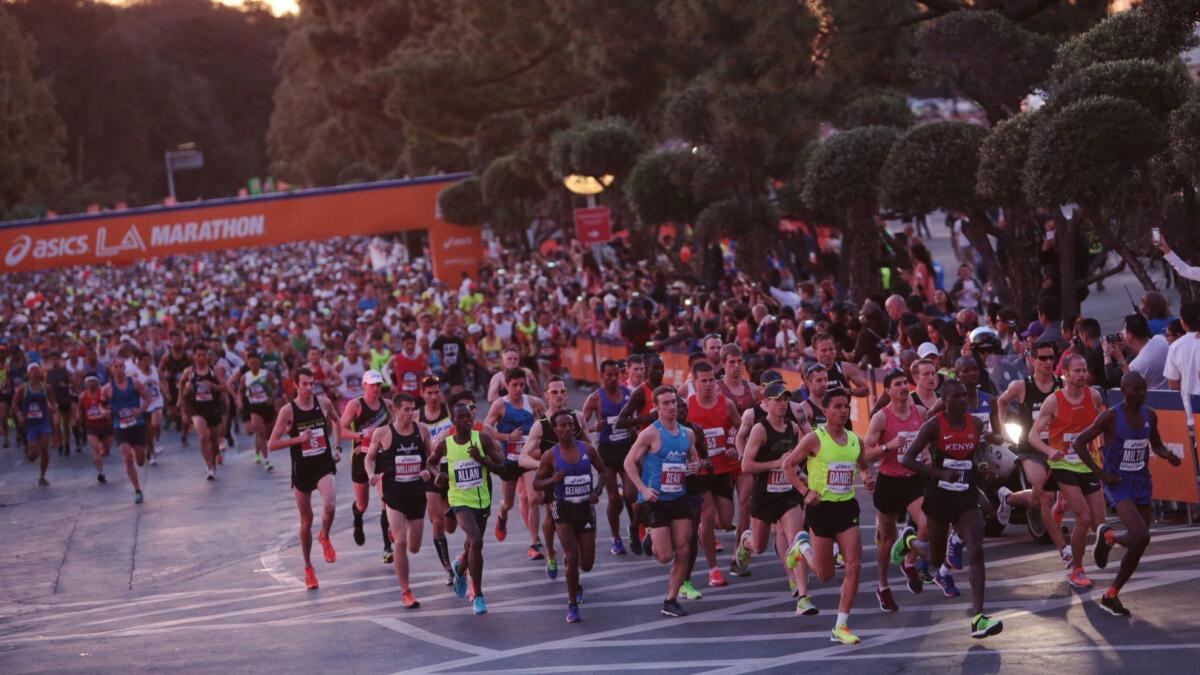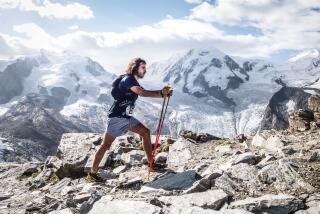Inspired by the L.A. Marathon? Here are 10 secrets veteran runners know all about

- Share via
Prepare to get bit by the running bug.
The L.A. Marathon takes place on Sunday, which means you’re about to be bombarded with inspirational images of super-fit people giving it their all. Want to join in? You probably know you’ll need high-quality kicks, sun screen and a beginner’s training plan for getting up off the couch. (One of the most popular apps out there is Couch to 10K.) So here are 10 secrets to running a great race that only veteran runners know. They cover running gear, race-day strategy and even changes to your form that might help you actually enjoy pounding the pavement, and run your best race:
For the record:
2:35 p.m. March 20, 2018An earlier version of this article gave the product name of the muscle massager as the Theragun G2. It is the Theragun G2Pro. The article also misspelled the last name of the device’s inventor, Jason Wersland, as Werland.
1. When in doubt, walk
Famed running coach Jeff Galloway, a 10,000-meter runner on the 1972 U.S. Olympic team, revolutionized marathon training for the masses with his run-walk-run method, which uses walking breaks to help beginning runners avoid injury. But the method also helps veteran marathoners set personal records. Just a few of the reasons why it works: Switching to a moderately fast walk gives your running muscles a break, allows you to grab a sip of water while still moving, helps lower core body temperature and gives you control at a time when you psychologically need it. If you’re struggling during a run, don’t be too proud: Just walk for a minute or two until you feel ready to run again. jeffgalloway.com
::
2. Get lubed
Nothing ruins a nice run like miles of blisters and chafing. That’s why lubricating all your friction-sensitive body parts (inner thighs, toes, armpits) with some sort of skin cream is a must. There are plenty to try on the market. We like Sportslick, an antibacterial, antifungal waterproof gel with a Vaseline-like feel. Applied by hand, it won’t miss the nooks and crannies you might with a roll-on lube. $12 for a 3.8-ounce tube or $5 for a 0.8-ounce size you can carry in your fanny pack. sportslick.com
::
3. Carry it
You may need a cellphone, car key, cash and electrolyte tablets, but you don’t need them bouncing around and wrecking your stride. The solution: the Flipbelt Classic, a comfortable, 4-inch-wide waist-band loop of sweat-wicking poly-Lycra that form-fits around your hips. (So no chafing from buckles or snaps.) Zip items into the belt, then flip it inside out to fix them in place around your waist. A rear zippered pocket on the outside keeps other items handy. $34.99. flipbelt.com
::
4. Knead for speed
Tight calves and hamstrings? Vibrational massage before a race helps work out the kinks, fast — a perfect job for the cordless Theragun G2 Pro. Popular with NFL trainers, this handled power tool lets you to get to hard-to-reach body parts and uses jackhammer-like movement to ease your pain. According to inventor Jason Wersland, a Culver City chiropractor, 20 seconds is more than enough to loosen up a tight muscle, with longer sessions appropriate for post-race recovery. $600. theragun.com
::
5. Avoid cramps
Many people get cramps during a marathon because they’ve sweated out too many electrolytes, which regulate nerve and muscle function. Sports drinks can help. But some runners swallow an electrolyte tablet or two every hour during a marathon. (Do yourself a favor: Discuss it with your doctor before giving it a try.) One we like: Saltstick Caps, which replace sodium, potassium, magnesium and calcium lost during a grueling workout. The capsules are widely available at stores that specialize in running and outdoors gear. saltstick.com
::
6. Watch those hands
Arm swing is ignored by most runners but shouldn’t be. A vertical arm swing — elbows and hands smoothly moving in a straight line, front to back, as you run — propels all your energy and momentum forward. But many of us swing cross-chest — elbows splaying out to the sides, hands swinging back and forth across the middle of the body — which sends your energy sideways and leaves you “rotating like a washing machine on every stride,” says Owen Anderson, author of “Running Form.” “That wastes energy, stresses your joints and causes you to run a slightly crooked line.” Tip: If you can see the back of your hands as you run, you are crossing your chest. Gently remind yourself to keep elbows in at your side, Anderson advises. Soon, it will become second nature. Also, balled-up hands create excessive muscular tension and contribute to a cross-chest swing. So relax the hands.
::
7. Bigger is better
Wear a hat or visor to keep sun off your face — the bigger the bill, the better. $19.95. phidippides.com/running-apparel/
::
8. Take the ‘talk test’
People “bonk” and hit the dreaded running wall by pushing too hard and going anaerobic — outstripping your body’s ability to deliver enough oxygen to meet its needs. You want to stay in the aerobic zone. How to do that? The “talk test,” says Carl Foster, co-author of “Be a Better Runner.” That means being able to speak in full sentences without gasping. To check yourself, try to say the Pledge of Allegiance out loud, while you’re running. If you can’t get through it without sucking for air, slow down.
::
9. Nip It
Male marathoners don’t want to read these words, but deal with it, dudes: bloody nipples. If you have a tendency to get rubbed raw, cover up with a couple bandages or go upscale. NipStrips aren’t cheap but are discreetly clear, stay stuck and peel off painlessly — and hairlessly. $14.99 for 20 pairs. nipstrips.com
::
10. The pre-race warmup
Experienced runners swear by the warm-up. We suggest you try it in training before putting it to the test on race day. “To run your best time, you need to get into your ‘second wind’ groove before you hit the starting line,” says legendary L.A. coach Laszlo Tabori, who became the third man in history to run a sub-4-minute mile and went on to train several Boston and New York Marathon winners. He’s famous for a 45-minute pre-marathon that many would consider a workout all its own. So, when you’re up to it, try this abbreviated version of his famous “Second Wind Warmup”: a 10-minute jog, three 50-yard sprints, a five-minute rest and four 20-yard sprints before you head to the starting line.






